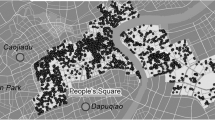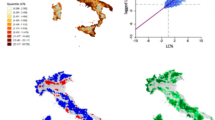Abstract
The space matters: beyond a mere background for economic activities placement, it constitutes a crucial element for their overall dynamism. This rationale, however, contravenes more traditional urban and regional economics approaches that interpret space as intangible within their spatial models. In that vein, notable constraints can be found in economic-based methods and spatial units oriented to spatialize the territorial endowments and interpret their role within the urban structure. While economics’ methods are limited in their spatial representation, urban and regional planning has otherwise focused in providing instruments that address spatial characteristics of areas where urbanization is predominant. Methods that highlight the configurational properties and the organization of the cityscape structure, could aid economics in its methodological issues. Still, a divide persists between these two fields of research, as neither consistently incorporates the methods and variables considered by the other. In this paper we showcase a method used to create a spatial unit oriented to territorialize economic-based datasets represented at a regional scale within the confines of urban areas’ industrial agglomerations. In this proof of concept, variables related to labour – average number of firms, employees, and firm-size; and to installed capital – average real estate prices – are spatialized to outline their patterns distribution across Tuscany’s cities. Organized in a GIS-based environment, the representation of such variables within a computerized space and with a proper spatial unit provides a basis that can be associated to the configurational aspects of the territory, being a complementary analysis for urban and regional planning.
Access this chapter
Tax calculation will be finalised at checkout
Purchases are for personal use only
Similar content being viewed by others
References
von Thünen, J.H.: Der isolirte Staat in Beziehung auf Landwirthschaft und Nationalökonomie, oder Untersuchungen über den Einfluss, den die Getreidepreise, der Reichthum des Bodens und die Abgaben auf den Ackerbau ausüben. Hamburg, Friedrich Perthes (1826)
Weber, A.: Theory of the Location of Industries. The University of Chicago Press, Chicago, 1929 (1909). https://doi.org/10.1086/254099
Alonso, W.: Location and Land Use. Harvard University Press, Cambridge (1964)
Muth, R.: Cities and Housing. University of Chicago Press, Chicago (1969)
Thisse, J. Walliser, B.: Is space a neglected topic in mainstream economics? Recherches Economiques de Louvain 64(1), 11-22 (1998)
Duranton, G., Henderson, J.V., Strange, W. (eds.) Handbook of Regional and Urban Economics: Regional and Urban Economics, vol. 5A. Amsterdam. Elsevier – North-Holland (2015a)
Henderson, J.V., Thisse, J.F., (eds). Handbook of Regional and Urban Economics: Cities and Geography, vol. 4. Amsterdam. Elsevier – North-Holland (2004)
Hillier, B.: Spatial sustainability in cities: organic patterns and sustainable forms. In: Koch, D., Marcus, L., Steen, J., (eds.) Proceedings of the 7th International Space Syntax Symposium. Royal Institute of Technology (KTH): Stockholm, Sweden. pp. K01:3 (2009)
Hillier, B.: The genetic code for cities: Is it simpler than we think? In: Portugali, J., Meyer, H., Stolk, E., Tan, E. (eds.) Complexity Theories of Cities Have Come of Age: An Overview with Implications to Urban Planning and Design. London: Springer, pp. 67–89 (2012). https://doi.org/10.1007/978-3-642-24544-2_8
Garau, C., Annunziata, A.: A method for assessing the vitality potential of urban areas. the case study of the metropolitan City of Cagliari, Italy. City Territ Archit 9, 7 (2022). https://doi.org/10.1186/s40410-022-00153-6
Araldi, A., Fusco, G.: Retail fabric assessment: describing retail patterns within urban space. Cities 85, 51–62 (2018)
Van Nes, A.: Road Building and Urban Change. The Effect of Ring Roads on the Dispersal of Shop and Retail in Western European Towns and Cities. Ph.D. Thesis, Department of Land Use and Landscape Planning, Agricultural University of Norway, Ås, Norway, 27 September (2002)
QGIS, Białowieża, version 3.22 (2022). http://www.qgis.org/en/site/index.html
Gervasi, O., et al. (eds.): ICCSA 2021. LNCS, vol. 12949. Springer, Cham (2021). https://doi.org/10.1007/978-3-030-86653-2
Altafini, D., Cutini, V.: Territorial disparities in Tuscan industrial assets: a model to assess agglomeration and exposure patterns. TeMA – J. Land Use, Mob. Environ. 14(2), 161–176 (2021b). https://doi.org/10.6092/1970-9870/7976
Altafini, D., Pozzobon, E., Rusci, S., Cutini, V.: Lo spazio nella contrazione industriale: specificità e risposte del patrimonio immobiliare produttivo toscano. In: Giaimo, C., Tosi, M.C., Voghera, A., (eds.) Tecniche urbanistiche per una fase di decrescita – Atti della XXIII Conferenza Nazionale SIU. Planum Publisher, pp. 12–19 (2021a)
Altafini, D., Pozzobon, E., Rusci, S., Cutini, V.: Computational planning support systems for regional analysis: real-estate values dynamics and road-networks configuration. In: La Rosa, D., Privitera, R. (eds.) INPUT 2021. LNCE, vol. 146, pp. 291–299. Springer, Cham (2021). https://doi.org/10.1007/978-3-030-68824-0_32
Toscana, R.: Direzione Urbanistica e Politiche Abitative - Sistema Informativo Territoriale e Ambientale – SITA.: Edificato 2k, 10k 1988–2013. (2019b). http://www502.regione.toscana.it/geoscopio/cartoteca.html
Lucas, R.: On the size distribution of business firms. Bell J. Econ. 9, 508–523 (1978)
ISTAT, 9° Censimento ISTAT dell’industria e servizi. Istituto Nazionale di Statistica, Roma (2011). https://www.istat.it/it/archivio/104317
ISTAT, Descrizione dei dati geografici e delle variabili censuarie delle Basi territoriali per i censimenti: anni 1991, 2001, 2011. Istituto Nazionale di Statistica, Roma (2016)
Agenzia Entrate. Banca Dati Quotazioni dell’Osservatorio del Mercato Immobiliare Direzione Centrale Osservatorio Mercato Immobiliare e Servizi Estimativi, Roma (2021)
Entrate, A.: Manuale della Banca Dati Quotazioni dell’Osservatorio del Mercato Immobiliare Istruzioni tecniche per la formazione della Banca Dati Quotazioni OMI. In: Guerrieri, G., Festa, M., Longhi, S., Cantone, G., Papa, F. (eds.). Direzione Centrale Osservatorio Mercato Immobiliare e Servizi Estimativi, Roma (2018)
Author information
Authors and Affiliations
Corresponding author
Editor information
Editors and Affiliations
Rights and permissions
Copyright information
© 2022 The Author(s), under exclusive license to Springer Nature Switzerland AG
About this paper
Cite this paper
Altafini, D., Cutini, V. (2022). Towards a Spatial Approach to Territorialize Economic Data in Urban Areas’ Industrial Agglomerations. In: Gervasi, O., Murgante, B., Misra, S., Rocha, A.M.A.C., Garau, C. (eds) Computational Science and Its Applications – ICCSA 2022 Workshops. ICCSA 2022. Lecture Notes in Computer Science, vol 13377. Springer, Cham. https://doi.org/10.1007/978-3-031-10536-4_25
Download citation
DOI: https://doi.org/10.1007/978-3-031-10536-4_25
Published:
Publisher Name: Springer, Cham
Print ISBN: 978-3-031-10535-7
Online ISBN: 978-3-031-10536-4
eBook Packages: Computer ScienceComputer Science (R0)




